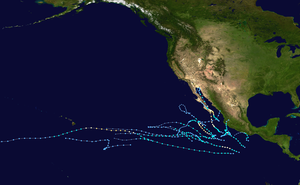
Back Temporada de huracanes en el Pacífico de 2003 Spanish Orkaanseizoen van de Grote Oceaan 2003 Dutch Temporada de furacões no Pacífico de 2003 Portuguese 2003 Pacific hurricane season SIMPLE 2003年太平洋颶風季 Chinese
| 2003 Pacific hurricane season | |
|---|---|
 Season summary map | |
| Seasonal boundaries | |
| First system formed | May 19, 2003 |
| Last system dissipated | October 26, 2003 |
| Strongest storm | |
| Name | Nora |
| • Maximum winds | 105 mph (165 km/h) (1-minute sustained) |
| • Lowest pressure | 969 mbar (hPa; 28.61 inHg) |
| Seasonal statistics | |
| Total depressions | 17 official, 1 unofficial |
| Total storms | 16 |
| Hurricanes | 7 |
| Major hurricanes (Cat. 3+) | 0 (record low, tied with 1977) |
| Total fatalities | 26 total |
| Total damage | $129 million (2003 USD) |
| Related articles | |
The 2003 Pacific hurricane season was the first season to feature no major hurricanes (storms of Category 3 intensity or higher on the Saffir–Simpson hurricane wind scale) since 1977. The season officially began on May 15, 2003 in the Eastern North Pacific (east of 140°W), and on June 1 in the Central (between 140°W and the International Date Line); both ended on November 30. These dates, adopted by convention, historically describe the period in each year when most tropical cyclogenesis occurs in these regions of the Pacific.[1] The season featured 16 tropical storms, 7 of which intensified into hurricanes, which was then considered an average season. Damage across the basin reached US$129 million, and 23 people were killed by the storms.[nb 1]
Despite the overall lack of activity, the season produced an unusually large number of tropical cyclones that affected Mexico, with eight tropical cyclones making landfall on either side of Mexico, which was the second highest on record. Tropical Storm Carlos struck Oaxaca in late June, resulting in nine fatalities. In late August, Hurricane Ignacio struck the Baja California Peninsula, killing four people and inflicting US$21 million in damage. In September, Hurricane Marty affected the same areas as Ignacio, and was responsible for 12 casualties and US$100 million in damage, making Marty the costliest and deadliest storm of the season. In October, Hurricanes Olaf and Nora struck western Mexico as tropical depressions, causing slight damage and one casualty.
Activity in the Central Pacific was below average, with only one tropical depression forming in the basin and one hurricane entering the basin from the East Pacific. In mid-August, Hurricane Jimena passed just to the south of Hawaii; it was the first storm to directly threaten Hawaii in several years. Also, the remnants of Tropical Storm Guillermo moved into the basin on August 12, prior dissipating the following day.
- ^ Neal Dorst (June 2, 2016). "TCFAQ G1) When is hurricane season?". Atlantic Oceanographic and Meteorological Laboratory. Archived from the original on May 6, 2009. Retrieved July 24, 2018.
Cite error: There are <ref group=nb> tags on this page, but the references will not show without a {{reflist|group=nb}} template (see the help page).
© MMXXIII Rich X Search. We shall prevail. All rights reserved. Rich X Search